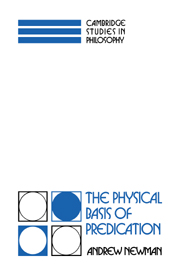Book contents
- Frontmatter
- Contents
- Acknowledgements
- Introduction
- Chapter 1 “Real constituents of the world”
- Chapter 2 What can logic and language tell us about reality?
- Chapter 3 The “existence” of universals and the notion of possibility
- Chapter 4 The causal significance of basic attributes
- Chapter 5 Hierarchies of universals
- Chapter 6 Causal relations
- Chapter 7 Arbitrary particulars and unified particulars
- Chapter 8 Further considerations concerning the causal relation
- Chapter 9 Arbitrary particulars and physical objects
- Bibliography
- Index
Chapter 8 - Further considerations concerning the causal relation
Published online by Cambridge University Press: 04 May 2010
- Frontmatter
- Contents
- Acknowledgements
- Introduction
- Chapter 1 “Real constituents of the world”
- Chapter 2 What can logic and language tell us about reality?
- Chapter 3 The “existence” of universals and the notion of possibility
- Chapter 4 The causal significance of basic attributes
- Chapter 5 Hierarchies of universals
- Chapter 6 Causal relations
- Chapter 7 Arbitrary particulars and unified particulars
- Chapter 8 Further considerations concerning the causal relation
- Chapter 9 Arbitrary particulars and physical objects
- Bibliography
- Index
Summary
THE LOGICAL FORM OF SENTENCES ABOUT CAUSALITY
One reason the problem of causality is difficult is that language and ordinary thought appear to presuppose what we can call the linguistically natural picture of causality. It appears to suppose that there are objects such as a, b, c, d,… that are causes and effects, and that there are relations between them that are causal relations. If there is a causal relation between a and b, then that causal relation is a matter of a's producing b, or a's being responsible for b, though these phrases merely further express our intuition. It is further supposed that causes and effects occur in causal chains: a causes b, b causes c, and so on. Russell ascribes this view to Mill.
Events are appealing as causes and effects, since they are at least particulars and are easily arranged into chains. They seem to fit the linguistically natural picture of causality. The main problem with events is that of finding a causal relation to link one event with another. This is a serious problem for events, as without causal relations to link them together events cannot be taken seriously as causes and effects. Physical objects, as we have shown, can enter into causal relations; but the problem with physical objects is that it is difficult to see them as causes and effects in the hoped for chain of causes and effects.
- Type
- Chapter
- Information
- The Physical Basis of Predication , pp. 185 - 207Publisher: Cambridge University PressPrint publication year: 1992



